You thought you were confused about mammograms before? Now the American Cancer Society has revised its guidelines, saying most women can start at age 45. The guidance still doesn't match what has been suggested by other groups and is sure to raise more controversy.
There’s big disagreement over when and how often women should get mammograms. Until Tuesday, the American Cancer Society said women should get one every year starting at age 40, as well as regular breast exams by their doctors.
The new American Cancer Society guidelines are far more complicated. They say women of average risk of breast cancer can wait until they’re 45 to have a first mammogram and should have them every year until age 55, and then start having them every other year.
Meet the tattoo artist making breast cancer survivors feel 'whole again'
This is a little closer to the U.S. Preventive Services Task Force recommendations that most women can safely wait until they are 50 to start getting mammograms, and that they only need one every other year.
The debate has become so heated at times that Congress passed legislation overriding the USPSTF guidelines, which are used as the basis for government health insurance policies.
The American Cancer Society’s new recommendations for women at average risk:
Women should undergo regular screening mammography starting at age 45.
Women 45 to 54 years of age should be screened annually.
Women 55 years and older should transition to biennial screening or have the opportunity to continue screening annually.
- Women should have the opportunity to begin annual screening between the ages of 40 and 44 years.
- Women should continue screening mammography as long as their overall health is good and they have a life expectancy of 10 years or longer.
- Clinical breast examination is not recommended for breast cancer screening among average-risk women at any age.
“The most important thing about our new guidelines is to validate that screening mammography is the most effective thing a woman can do to reduce her chances of dying of breast cancer,” the cancer society’s Dr. Richard Wender told NBC News.
“A woman should make a personal decision as whether she should start screening before age 45 but we clearly recommend that by age 45 all women should start regular screening every year.”

For the new recommendations, published in the Journal of the American Medical Association, a team of experts studied all the research they could find on the risks and benefits of mammograms.
They found that regular mammograms in women aged 40 to 69 did reduce the number of breast cancer deaths.
This evidence outweighs the occasional study that finds otherwise — such as a large 2014 Canadian study that cast doubt on whether mammograms actually reduce the risk of dying from breast cancer, and a 2012 study published in the New England Journal of Medicine that found that as many as a third of cancers detected through routine mammograms may not be life-threatening.
The researchers said at the time that 1 million women may have been overdiagnosed, which means they were needlessly treated, not to mention emotionally distressed.
At least one study has showed that many women suffer intense anguish after they get called for a follow-up mammogram when a radiologist has spotted something suspicious.
Dr. Therese Bevers of MD Anderson Cancer Center, who helps set breast cancer screening guidelines for the National Comprehensive Cancer Network, doesn’t think the new advice is going to clear up the confusion.
“This is one more set of recommendations that will be confusing to women and their primary care providers,” Bevers said. “Women are going to have questions and their providers may not know how to address them.”
Annual ritual for millions
Breast cancer is a leading killer of U.S. women. Every year, it's diagnosed in 200,000 women and a few men, and kills around 40,000.

Mammograms are an annual ritual for millions of American women, considered so important that federal law mandates that most health insurance plans pay for them without charging the patient anything. The X-rays can detect tiny tumors long before they are big enough to be felt.
And research clearly shows that treating a tumor early makes for easier, less invasive surgery and can save lives.
The guidelines are for women of average risk. Women whose mothers, sisters or other close relatives had breast cancer, or who know they have a genetic mutation that raises their own risk, should start sooner.
“Though the evidence shows that there are some benefits from mammography screening starting at age 40, those benefits more clearly outweigh the harms from age 45 onward," said Dr. Elizabeth Fontham, dean of the School of Public Health at Louisiana State University and the chair of the group that developed the guidelines.
"Still, some women will choose to begin screening between age 40 and 44, both because they are concerned about their risk of breast cancer, either in general or because they are at higher risk, and are less concerned about the chances of experiencing a false positive findings. Those women should have the opportunity to start screening at 40 if they choose.”

The USPSTF issued a statement saying the new American Cancer Society guidelines are closer to its own.
“Importantly, both identify strategies that help women, together with their doctors, identify and treat this serious disease. We both found that the benefit of mammography increases with age, with women in their 50s, 60s, and early 70s benefiting most from regular mammography screening,” the group said.
“The USPSTF’s draft recommendations and the new ACS guidelines both recognize that a mammogram is a good test, but not a perfect one, and that there are health benefits to beginning mammography screening for women in their 40s.”
What’s most important, both groups agree, is for a woman to talk about her risk with her doctor, and decide what she’s most comfortable doing.
Breast cancer risk can be genetic but most cases of breast cancer are in women who had no known family history of the disease.